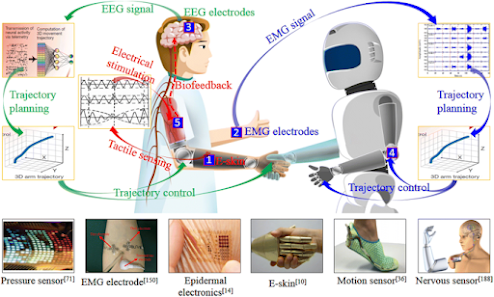Human-Machine Communication (HMC) refers to the interaction and exchange of information between humans and machines or artificial intelligence systems. It encompasses various technologies and interfaces that facilitate communication and collaboration between people and machines. HMC plays a pivotal role in advancing automation, enhancing user experiences, and enabling machines to understand and respond to human input. Here's a detailed description of Human-Machine Communication:
Natural Language Processing (NLP): HMC leverages NLP to enable machines to understand and process human language. This includes speech recognition and text analysis, allowing machines to interpret spoken or written words, generate human-like responses, and provide information or perform tasks based on language input.
Voice Assistants and Chatbots: Voice-activated virtual assistants like Amazon's Alexa, Apple's Siri, and Google Assistant, as well as chatbots, exemplify HMC. These systems understand and respond to spoken or typed commands, assisting users with tasks, answering questions, and controlling smart devices.
Human-Machine Collaboration: HMC fosters collaboration between humans and machines, particularly in workplaces where automation and AI technologies assist employees in tasks ranging from data analysis to decision-making. Machines can offer suggestions, automate routine processes, and augment human capabilities.
User Interfaces (UI) and User Experience (UX): Human-Machine Communication is essential in designing intuitive and user-friendly interfaces. This includes touchscreen interfaces, gesture recognition, and augmented reality (AR) interfaces, making it easier for users to interact with machines seamlessly.
Autonomous Vehicles: Communication between humans and autonomous vehicles is a vital aspect of HMC. Vehicles need to interpret and respond to human signals, such as hand gestures or vocal commands, to ensure safe and efficient transportation.
Healthcare and Telemedicine: In healthcare, HMC enables remote consultations with healthcare professionals through video calls and monitoring of vital signs using wearable devices. It also includes the use of robotic surgical systems guided by human surgeons.
Emotional AI: HMC is advancing to the point where machines can recognize human emotions through facial expressions, voice tone, and text sentiment analysis. This can be applied in customer service, mental health support, and human-robot interactions.
Ethical and Privacy Considerations: As HMC becomes more prevalent, issues related to ethics, data privacy, and security come to the forefront. Protecting sensitive information and ensuring the responsible use of AI are critical concerns.
Education and Training: HMC plays a role in educational settings, where AI-powered tools can adapt to individual learning styles, provide personalized feedback, and support both teachers and students.
Entertainment and Gaming: Virtual reality (VR), augmented reality (AR), and gaming systems rely on HMC to create immersive experiences, track user movements, and respond to gestures and voice commands.
Accessibility: HMC helps individuals with disabilities by providing assistive technologies, such as screen readers, voice-controlled devices, and communication aids.
Future Innovations: HMC is an evolving field with ongoing research and development. Innovations may include brain-computer interfaces (BCIs), direct mind-machine communication, and even more advanced forms of AI-human interaction.
Human-Machine Communication is at the forefront of technological advancements, transforming how we interact with machines and AI systems. It has the potential to improve efficiency, accessibility, and the overall quality of human-machine interactions across various domains of life and work. However, it also raises important ethical, security, and privacy considerations that must be carefully addressed as the technology continues to evolve.
Website Visit: https://x-i.me/comms
Instagram : https://x-i.me/insta1
Twitter : https://x-i.me/twit
Facebook : https://x-i.me/cfb
Pinterest : https://x-i.me/print
Tumblr : https://x-i.me/tum





No comments:
Post a Comment